The Seated Arnold Press is a variation of the classic dumbbell shoulder press exercise that targets multiple muscles of the shoulder complex. Named after the legendary bodybuilder Arnold Schwarzenegger, this compound exercise works simultaneously on the anterior, medial, and posterior deltoids, in addition to supporting muscles like trapezius and rotator cuff muscles.
It’s a great option for strength and hypertrophy of the shoulders. But, is the Arnold press actually effective? And does it do anything special that the regular dumbbell press doesn’t?
Related: Arnold Press Muscles Worked and Comparison With the Dumbbell Shoulder Press
How to Do the Seated Arnold Press
To perform the Seated Arnold Press, begin by sitting upright on a bench with slightly declined back support. Kick the dumbbells up off the knees and hold a dumbbell in each hand at shoulder level. The palms should be facing toward your body, and elbows tucked close. Press the dumbbells overhead while rotating the arms so that the palms eventually face away from the body at the top of the movement. Lower the dumbbells back down to the starting position while reversing the rotation to complete one repetition.
The Seated Arnold Press is a good option for anyone looking for a seated shoulder press variant or more muscle mass on the front delts. It’s an easy exercise to learn and can be adapted to any fitness level, though it may be more suited to experienced lifters.
New lifters may have difficulty coordinating and timing the rotation and press while also following a consistent pressing path.

About the Seated Arnold Press
History and Origin
The Seated Arnold Press is a variation of the traditional shoulder press exercise named after Arnold Schwarzenegger. It’s mostly used for building strength and muscle mass in the deltoid muscles. While this move is rarely seen outside of YouTube or influencer bodybuilding circles, the seated Arnold press might be a worthwhile variation to use if:
- Your standard shoulder press movement has plateaued and you want to use a fresh alternative exercise.
- The focus is on muscle hypertrophy, particularly in the front and side delts.
- Strength-endurance is the goal
- You want to train your shoulders through a fuller range of motion.
- You want an inherently less stable shoulder press move resulting in slightly lower systemic fatigue.
- You enjoy it.
Fun fact. While the movement is named after the iconic Austrian oak, did Arnold ever do the Arnold press? Bodybuilding renegade and fellow Australian Lee Priest has a colourful take.
View this post on Instagram
Muscles Worked in the Seated Arnold Press
The primary muscles worked by the Seated Arnold Press are the deltoids, which consist of three heads: the anterior, medial, and posterior deltoids. This exercise will hit all three heads of the deltoids, with an emphasis on the front delts (1). Additionally, the movement also involves the triceps, traps, and upper back muscles to a lesser degree.
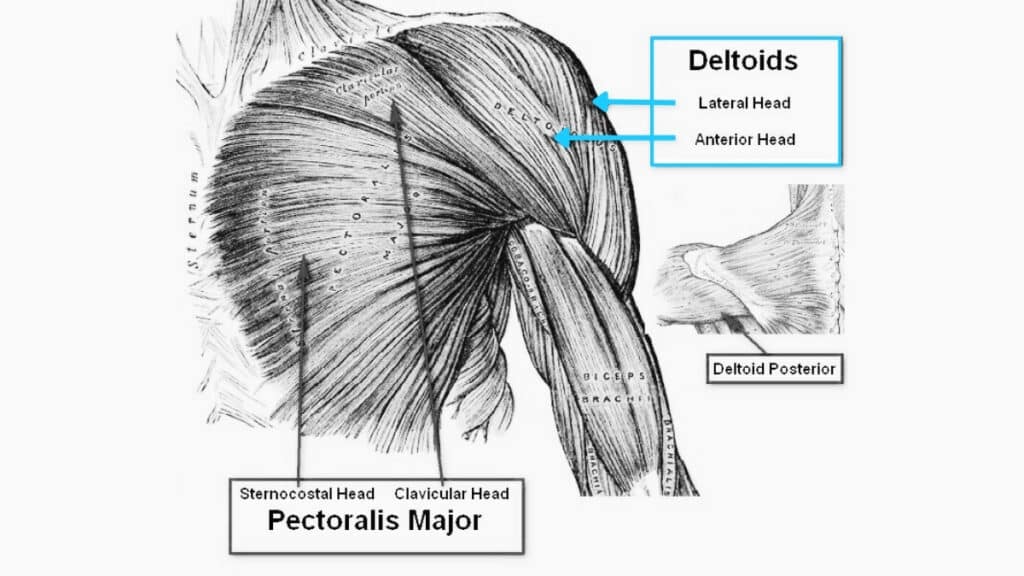
Targets All 3 Deltoid Heads?
There are three main determinants of which of the deltoid heads will be targeted and to what degree during pressing:
- Arm path
- Direction of resistance
- Range of motion used
For most overhead presses the front delts are going to be the primary working muscles. Here they’ll initiate movement out of the bottom position, and then contribute to adduction toward the top (2,3). It is that initial position with elbows in front of the body that activates the front and side delts more than with standard presses (1).
The middle fibers work mostly through the middle portion of the range, pulling the arm outward into abduction and internal rotation (2,3).
The posterior delts draw the arms backward and stabilise at the top.
The traps provide support for the entire shoulder girdle during arm movement at all phases of the press. They’re most notably activated during elevation at the top of the press.
The triceps will contribute somewhat to stabilising and extending the elbows but not enough for significant hypertrophy here.
The four muscles of the rotator cuff act as a dynamic stabiliser to keep the humerus in its socket during arm motion.
Related: Arnold Press Muscles Worked and Comparison With the Dumbbell Shoulder Press
Main Muscles Worked by the Arnold Press
One study compared muscle activation of the front and side delts during dumbbell shoulder presses and Arnold presses. In both exercises, the front delts were the primary mover with significantly more activation than the medial deltoid.
The Arnold press showed slightly more muscle activation on both the anterior and medial deltoids when compared with the regular dumbbell overhead press (1).
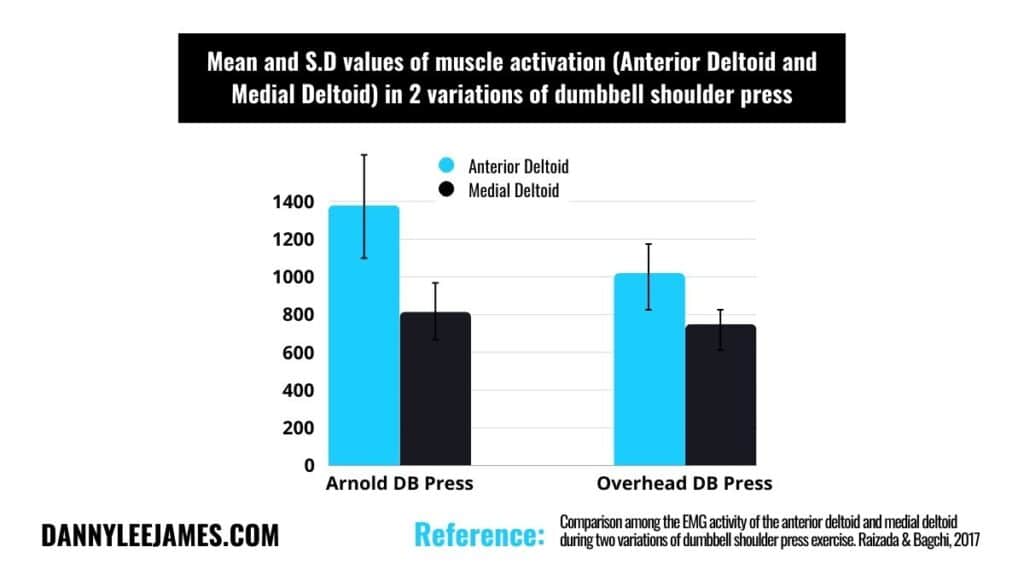
Is the Arnold Press Actually Effective?
Research indicates that due to the different arm paths, the Arnold press is more effective for producing shoulder hypertrophy (front and side) as compared to dumbbell shoulder presses.
Benefits of the Seated Arnold Press
Some key benefits of the Seated Arnold Press include:
- Enhanced Shoulder Strength: The unique range of motion involved in the exercise helps to target the bulk of the shoulder muscles, resulting in slightly more balanced shoulder development and improved shoulder strength. While the main focus will be on the front and side delts, expect a little posterior delt and trapezius if you’re pressing heavy and strictly vertical.
- Improved Stability: Pressing dumbbells overhead requires the engagement of several muscles, including the delts, rotator cuff, triceps, traps, and upper back muscles, helping to enhance overall shoulder stability at end range. The shoulder joint is also one of the most mobile joints in the body. The glenoid cavity is quite shallow and there are fewer ligaments providing support. All the muscles involved play a crucial role in stabilising the shoulder joint, supporting its movements, and maintaining joint integrity.
- Increased Range of Motion: Starting the movement with arms in front rather than out to the side (frontal plane) involves a fuller range of motion for the anterior deltoid. At the top of the rep, dumbbells allow the arms to come closer, resulting in a greater range of motion than a barbell or machine press. This helps to better activate the targeted muscles and further enhance muscle development and mobility.
- Versatility: The Seated Arnold Press can be easily incorporated into a training program, either as a standalone exercise, an accessory, a substitute, or combined with other shoulder-focused exercises for a more comprehensive program.
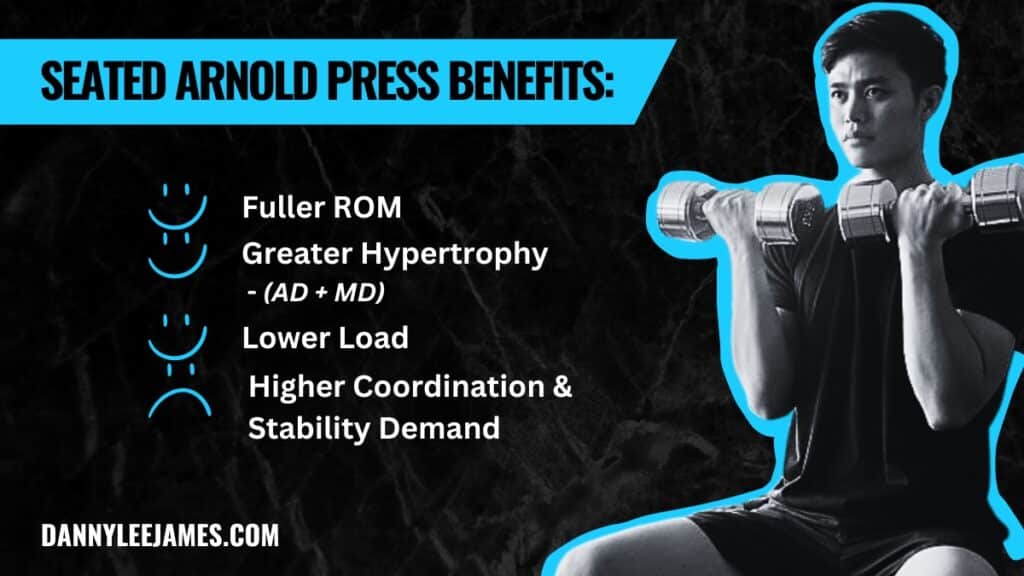
Who Should Do the Seated Arnold Press?
While the Seated Arnold press may not be your first shoulder press option, that’s not to say it’s without value.
Strength Sport Athletes
For Strongmen, Powerlifters, Weightlifters, and other strength athletes who may spend the majority of training on traditional barbell lifts, Arnold press variations can be a useful supplement to include in a program.
The seated Arnold press can train mobility and stability of the shoulder and scapula that may be complimentary or restorative to the usual training at a lower systemic cost.
Bodybuilders
Bodybuilders often incorporate various shoulder exercises to sculpt and develop full muscles and an overall symmetrical physique. The seated Arnold press can be a valuable addition to their routine for targeting different areas of the shoulder complex.
Training muscles through a bigger range means more muscle growth with lower net training loads. This press is a great option if you’re looking for more shoulder mass, a change from the usual, and that’s a little more joint-friendly for the shoulders.
Fitness Enthusiasts and Regular Gym-Goers
If you want a bang-for-your-buck movement that does a little bit of everything, from building shoulder strength and size to mobility, stability, endurance, and good mind-muscle connection, the seated Arnold press has it all. And since it will hit all three heads of the shoulder it might just be one of the only shoulder press movements you’ll need.
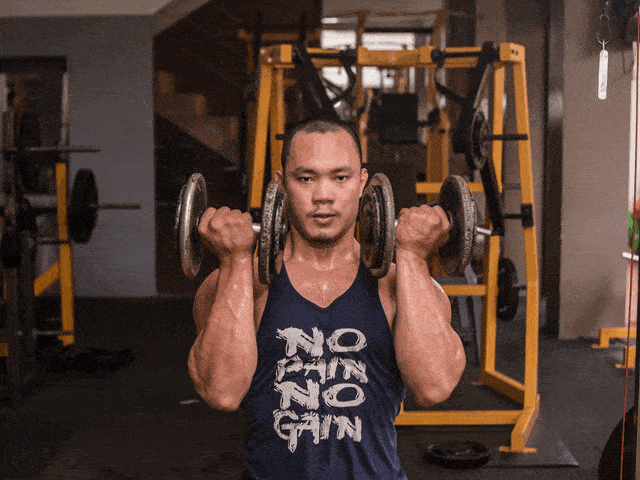
How To Seated Arnold Press
Here’s how to do the Seated Arnold press correctly, from set up to execution.
What is the best angle for the Seated Arnold press?
Before beginning the Seated Arnold Press, sit on a bench with an adjustable back support set on a very high incline, and a pair of dumbbells in your hands. Like the standard shoulder press, you want to set the back support slightly lower than the fully upright position. Pressing from this angle will help train the front shoulders from a more lengthened position and likely use less of the trapezius.
Starting Position
Now, place your feet firmly on the ground, ensuring a stable base. Hold the dumbbells close, with your palms facing towards your body, and position them at shoulder height with your elbows bent. Maintain an upright posture throughout the exercise and brace your core.
Movement and Technique
To perform the Seated Arnold Press, begin by initiating the upward motion of the dumbbells while rotating your wrists outward so your palms face forward. Simultaneously, extend your arms straight above your head, pressing the dumbbells towards the ceiling and behind you.
Pause briefly at the top of the movement before slowly returning to the starting position by reversing the rotation, bringing the dumbbells back to shoulder height with your palms facing your body.
In most cases, avoid pausing at the bottom of overhead dumbbell presses; instead, smoothly transition into the next repetition to capitalize on stored elastic energy from the stretch position. Pausing dissipates this energy and increases inertia resulting in increased difficulty and fewer reps completed.
How to do the Arnold press correctly
The Arnold press can also be less effective if you complete the rotation of the dumbbells before you begin the press. With gravity pulling straight downward, this would do little more than fatigue your shoulders and traps and maybe your forearm pronators and supinators.
You have to rotate your arms AS YOU PRESS, beginning the moment you initiate upward motion.
Due to rotating the dumbbells be strict with your pressing form and lower the weights back to start under control.
Be sure to focus on pressing the weight directly up and back in a straight line and not creating a wide arc that resembles a full-range lateral raise.
Finally, keep a firm grip on the dumbbells throughout the movement for smoother form and better rotator cuff recruitment.
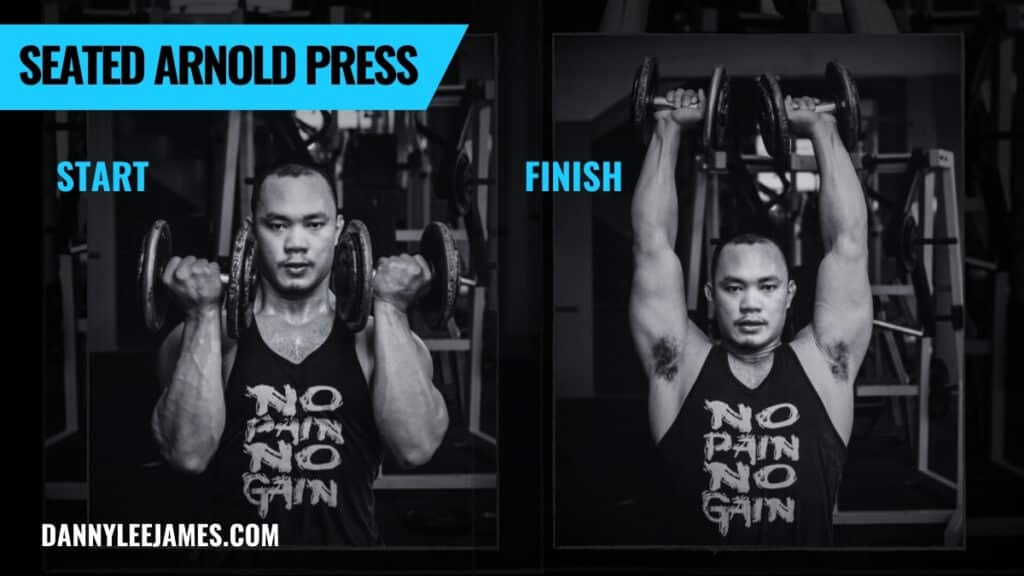
Breathing Pattern
Like any exercise, it’s important to maintain a proper breathing pattern during the seated Arnold press.
We could be a lot more nuanced and get into pressure and breathing dynamics during lifting. But, for those who just want to know when to breathe in and out during an exercise, this general framework will be enough for most people most of the time.
Right before you begin you’re going to exhale first and then keep the abdominal area tight. Next, Inhale a little air while keeping that tightness in the abdomen right before you rotate your wrists and begin pressing upward. Now exhale with a short burst of breath as you press the dumbbells into the final lockout position. You will take in a little air again as you lower the weights into the bottom position and right before you begin the transition to the press again.
This breathing pattern helps to stiffen and relax the core intermittently, maintain stability, and ensure enough oxygen flow throughout the movement.
How to Breathe When Lifting Heavy Weights vs Light Weights
When lifting light to moderate loads (approx 12-30 RM) the need for global muscle activation to enhance stability, spinal support, and efficiency is less significant. So, a strong brace or specific breathing pattern isn’t as important. You still want to maintain some degree of stiffness in the torso but breathe in and out with a regular cadence that works for you and don’t overthink it.
For novice trainees, an overreliance on breathing tempo may divert focus away from the quality of effort needed to properly execute the movement.
When lifting heavier weights, however, proper breathing and bracing become crucial for maintaining a rigid torso, reducing unwanted movement, and providing a stable base from which to generate maximum force through the limbs.
Related:
Common Mistakes Performing the Seated Arnold Press
- Poor posture: Maintain an upright posture while executing the Seated Arnold Press to avoid unnecessary load to tissues in the neck or shoulder. This will help ensure a proper arm path, scapulothoracic articulation, and force couples between the deltoid muscles and rotator cuff. The role of the rotator cuff is to support the arm in its socket while the deltoids pull the arm in many directions. A balance between these muscles helps keep the head of the humerus centred in the joint during motion. The set-up position of the spine and ribcage is a key part of this.
- Incomplete rotation: Rotate your wrists fully as you press the dumbbells overhead to target the shoulder muscles effectively. Maximum pushing force happens via internal rotation. Using a full rotation enhances muscle activation of supporting muscles, the stretch-shortening cycle for more powerful presses, and ensures optimal joint mechanics for efficient force transfer.
- Using momentum: Focus on using a controlled motion when pressing the dumbbells overhead, avoiding the temptation to use momentum or swing your body to complete the lift. This will keep your technique standardised and target the intended tissues for growth and strength.
- Using too much weight: Rotating the dumbbells while pressing increases the technical demand of an already unstable exercise. With each limb working independently to control a heavy implement the risk to shoulder health is higher. For some, the forearms may fatigue first from rotating heavy weights, reducing the stimulus to the shoulders. Instead focus on moderate loads (10-20 RM), a full range of motion, perfect technique every rep and a good mind-muscle connection.
- Not using enough weight: Most muscles will respond to a variety of repetition ranges.Training too light and far from an effective RIR can result in a lot of ”junk volume” that doesn’t stimulate much in the way of new muscle. You may end up instead only accumulating fatigue with no upside.
Performing the Seated Arnold Press correctly provides numerous benefits, such as increased shoulder muscle size, strength, stability, and improved range of motion. By paying close attention to technique, posture, proper breathing, and load, you’ll get the most out of this exercise and minimise the risk of injury now and in the long term.
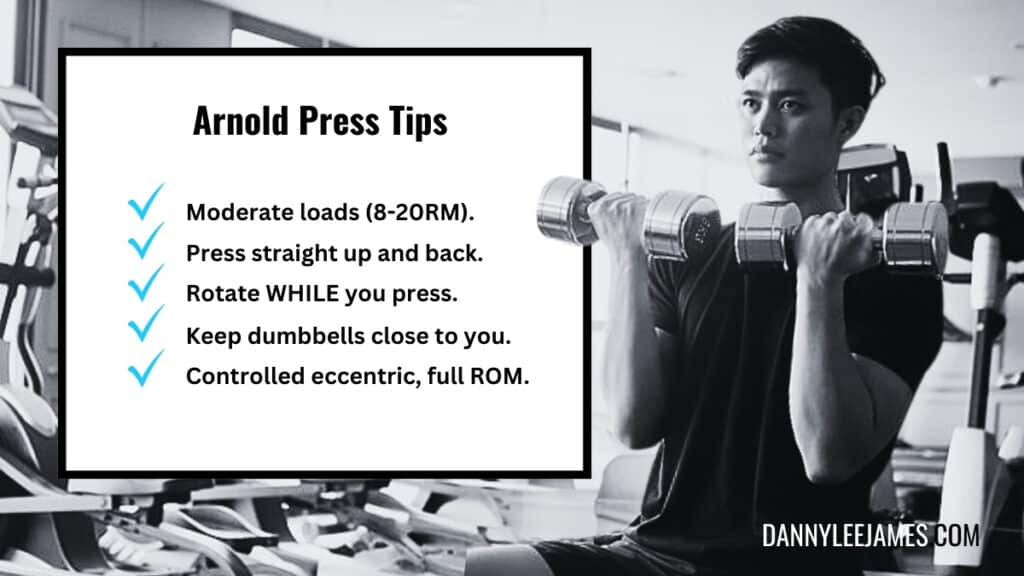
Seated Arnold Press Variations and Modifications
Standing Arnold Press
The Standing Arnold Press is a variation of the traditional Seated Arnold Press, targeting the same muscles, including all three heads of the deltoid, as well as the trapezius, biceps and triceps. This modification involves performing the exercise while standing, which can provide a greater challenge to the core and overall balance.
Is seated Arnold Press Better Than Standing?
Some research has shown higher muscle activation of the deltoids with standing dumbbell presses in comparison to seated, or military presses (4). The Seated Arnold Press was not explored in this study. However, one study found Arnold presses result in greater deltoid muscle activation than standard dumbbell presses (1).
To perform this variation, begin by standing with your feet shoulder-width apart, holding a pair of dumbbells at shoulder level, palms facing you. As you press the weights overhead, rotate your wrists to a palms-facing-forward position.
While you’re pressing the weight upwards, be sure not to lean back too much. Maintain a small amount of thoracic extension throughout the lift, and try to engage the core, keeping the ribs down as you ”strict press” the weight overhead. Lower the weights back to the shoulders under control.
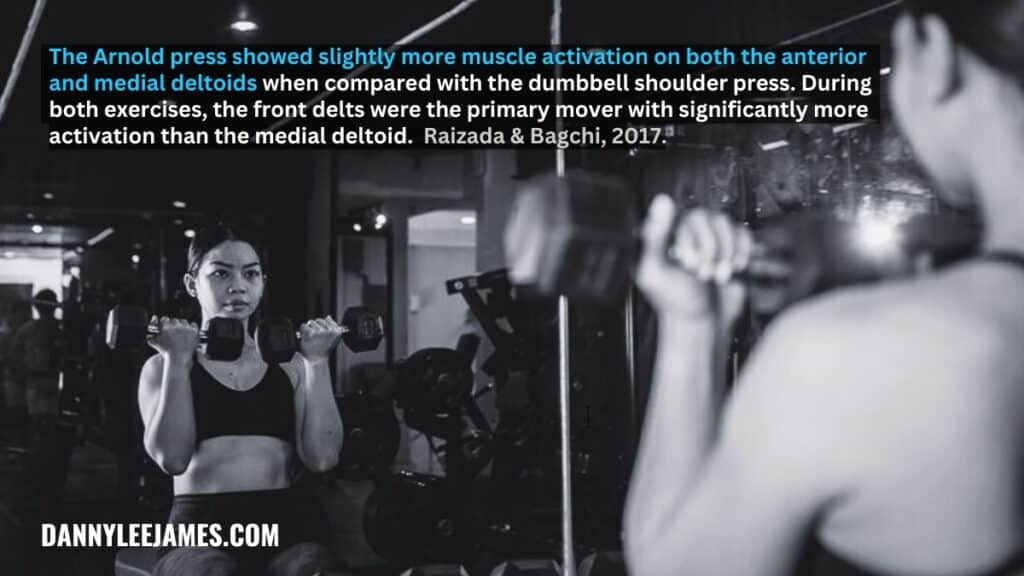
Should You Do the Arnold Press Sitting or Standing?
While there’s no direct evidence exploring the differences between them, for most lifters results will probably be similar. A seated Arnold press offers more support and stability. The standing Arnold press requires control of more segments and extra care to avoid leaning back too much.
The standing Arnold Presses may result in greater overall muscle activation but the differences are only minor. Perform the variation that you can perform consistently with good technique and alternate over time when progress slows.
Arnold Push Press
The Arnold push-press is a dynamic compound exercise that combines a slight squat with a powerful overhead press. The push is initiated with a quick dip and drive of the legs to generate momentum, get the weight moving and finish the press.
Begin with your feet shoulder-width apart. Hold a dumbbell in each hand at shoulder level with your palms facing you. Slightly bend your knees and dip your torso, sitting straight down without leaning forward. This is a quick and shallow squat to generate momentum. Explosively drive through your heels and use the thrust from your lower body to help punch the dumbbells overhead, rotating them as you push. Extend your arms fully at the top with palms now facing away.
Once your arms are fully extended above you, pause briefly at the top of the movement. Lower the weights back to the starting position at your shoulders in a controlled manner, ready to begin the next repetition.
These can be performed continuously, or with a brief pause between reps.
The Arnold push press is a good option if you want a whole-body derivative that develops vertical explosiveness. Keep the rep count low, reps fast, and stay away from muscular failure to develop power qualities.
Alternating Arnold Press
The Alternating Arnold Press can provide a more dynamic way to focus on each arm individually. Unilateral versions also allow for more lateral flexion of the trunk toward the non-working limb. This may create some space for the shoulder at the top of the movement. For lifters with a history of closing joint pain or impingement, this press is a great option.
To perform this variation, follow the same execution as the traditional Seated Arnold Press, but press one arm overhead at a time. You can do them continuously or pause on one side until you’ve completed a full rep with the other limb.
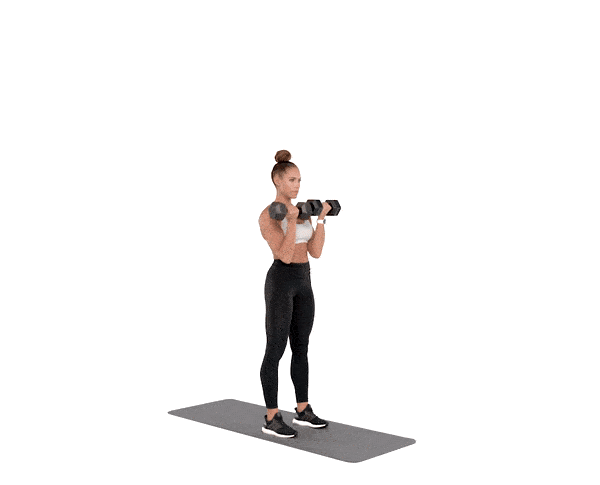
Single Arm Arnold Press
The single-arm Arnold Press also allows the lifter to work each arm independently. Either by performing reps with one arm at a time with the same dumbbell, or by holding a weight in the start position on one side while you perform reps on the other. The problem with the latter option, however, is that you may fatigue the ”resting” shoulder too much to get anything out of it during the press.
The other benefit of unilateral pressing is the greater focus on one arm at a time if an injury has occurred on one side, or inter-limb strength or mobility is asymmetrical.
If a significant imbalance exists, you can train each arm with the specificity that it currently needs.
Seated Arnold Press Alternatives
Dumbbell Seated Shoulder Press
If adding the twist isn’t for you, the regular dumbbell shoulder press will be a suitable Arnold press alternative. To achieve a similar effect, try pressing with palms facing each other and elbows pointing more forward in the sagittal plane. There may be less involvement of the lateral and posterior fibers.
Is it better to do the overhead shoulder press with palms facing forward or each other?
It depends on the training goal and shoulder structure. Often shoulder joints can feel more comfortable pressing with the palms facing each other (neutral grip). This is because it creates a little more space between the humerus and acromion process at the top than a standard grip and reduces potential impingement mechanisms.
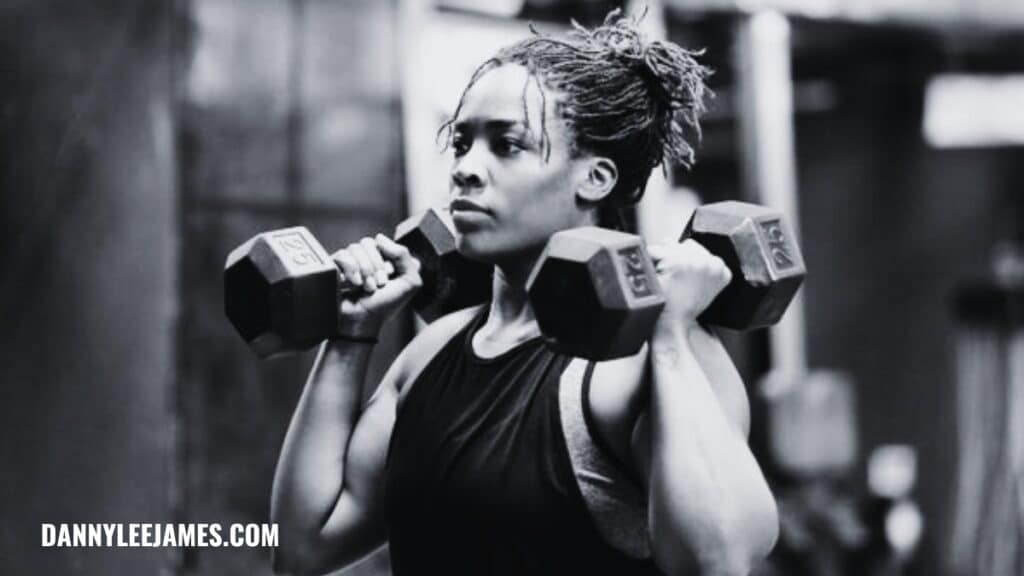
Machine Shoulder Press
The seated machine press typically offers a more guided and controlled movement compared to free-weight pressing. The fixed path may also result in more tricep recruitment toward the top of the press. To achieve similar results as the Arnold Press for the shoulders, use the neutral or narrow grip handles and press with the arms more in front of the body.
Integrating the Seated Arnold Press into Your Workout Routine
Warm-Up and Mobility
Before incorporating the seated Arnold press or any shoulder press into your training, it’s important to make sure you have enough shoulder mobility to get into positions you want to train in. For an overhead press, a simple table passive shoulder flexion test will determine if the joint can get into position to absorb and adapt to stress.
If it cannot, simply adjust the angle of the bench to accommodate the angle you can get to. That way you can still train and make progress with less risk, while you continue working to gain shoulder mobility separately.
The warm-up is not the place to insert mobility drills to gain shoulder mobility for the session. Rather, it’s where you want to prepare the mobility you have for what you’re about to do.
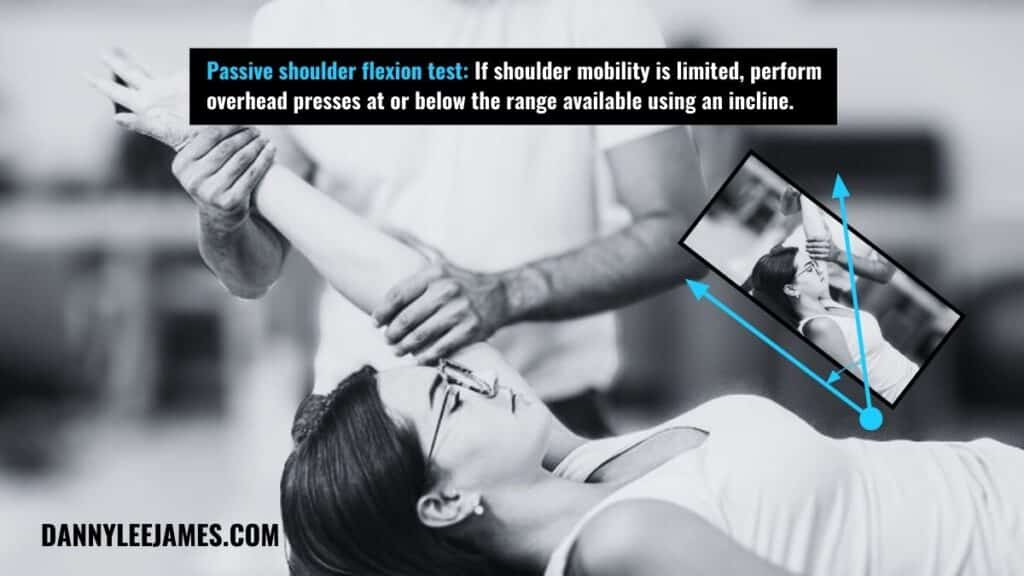
How to Warm Up the Shoulders
Most general fitness enthusiasts don’t need a warm-up specific to the lift they’re about to perform. That’s what build-up sets will do. However, most people could benefit from a warm-up specific to the structure and function of the shoulder joint itself. This approach will prepare your shoulder for the workout no matter what exercises you’re planning to do.
Pick movements from the following:
- Ribcage/T-spine
- Scapula strength/stability and rotator cuff
- Glenohumeral joint internal rotation and external rotation
There will likely be some crossover with these movements and individual needs may vary, but here’s an example of an upper-body push-focused warm-up:
- Dynamic side plank from the knees for lateral compression of the ribcage and shoulder internal rotation.
- Bear crawls, heavy single-arm overhead dumbbell carries for scapula and rotator cuff stability.
- Single-arm cable push/pull for shoulder motion into IR and ER.
My recommendation for shoulder warm-ups is to instead, establish the necessary mobility, stability and strength in all directions in your training long-term. In the beginning, your warm-ups may be more protracted based on needs.
The end goal is to be able to perform with minimal preparation or need for extensive and specific warm-ups in the first place.
Workout Placement
When integrating the Seated Arnold Press into your program, it’s crucial to determine the appropriate placement within the session and program. Exercise order will be a far bigger determinant of your training results than exercise selection, or exercise technique.
Why is that?
Because muscles respond to tension and recovery, not the exercise providing it. Form is highly variable between individuals and between repetitions, too.
Exercise Order
Typically, the Seated Arnold Press is performed after compound exercises such as the bench press or military press towards the end of a session. This is because it’s often viewed as more of a supplementary movement than a primary compound exercise with the highest return. The greater complexity also makes it less appealing for many in comparison to other seated shoulder press alternatives.
Which makes sense. Conventional wisdom implores you to perform complex, heavy, multi-joint movements first, when you’re fresh and have more energy. Train the smaller or single-joint muscles last, which are less important once they’re already warmed up.
However, the research tells us the order of exercises in a workout affects the number of reps that can be performed.
Best Exercise Order
Studies show exercises performed at the end of a session result in significantly fewer repetitions completed, compared to when the same exercises were performed at the start.
And it doesn’t matter if it was a single joint exercise involving one muscle, or a compound lift involving many muscle groups.
Movements performed first in the workout perform better, leading to better results.
Another study concluded that fewer reps per set were achieved in exercises performed later in the workout, even if no other exercises involved training that same muscle. This is likely due to central nervous system fatigue from the workout.
The takeaway:
If an exercise or the qualities it develops are a training priority, then place it at the beginning of your training session. Exercises done first in training result in more progress. It doesn’t matter if it’s a large or a small muscle group, and it doesn’t matter if it’s the only exercise for that muscle.
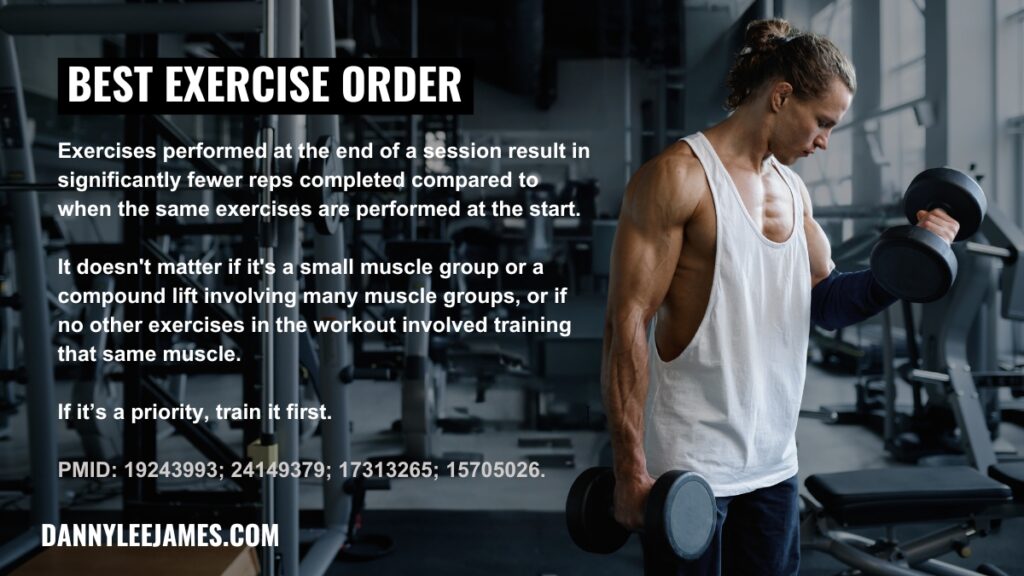
Workout Volume for the Front Delts
The front delts are heavily involved in any pushing exercises you do, so they’ll need very little direct training to make substantial progress (2,3,4,5). As a result, many lifters find they’re even able to maintain their front delt size for some time after removing direct work altogether. So long as there is some element of compound pressing still in the program for the chest or triceps.
Individual volume needs will vary, but for most intermediate lifters, training them 2x PW for around 10 total sets per week at the upper end will be enough.
Limiting front delt training to one exercise per session is recommended to prevent excessive volume overlap and preserve other pressing movements for future programs. It will also help to avoid overtaxing the front delts which could impact performance in all pressing movements for the chest and triceps.
Loading the Seated Arnold Press
Like most muscles, the shoulders will respond well to a variety of repetition ranges. More moderate loads (between 8-20 RM) may work best due to the instability and rotation involved in the Arnold press. Moderate loads here also offer a better balance of stimulus, fatigue, risk, and fiber-type specificity to maximise shoulder gains.
Using heavy weights (5-10 RM) can compromise form and stability, increasing the risk of injury and reducing the focus on the targeted muscles.
Arnold Press Sets and Reps
While you can build strength using the Seated Arnold Press, it’s not the best option for pure overhead pressing strength. The fuller range of motion, coordination and stability required make it difficult to perform with heavy loads. Instead, use the seated Arnold Press for muscle-building and strength endurance with light to moderate loads. Practice excellent form using a full range of motion and controlled tempo on every rep.
- For Muscle-Building: Perform 2-4 working sets of 8-20 reps at or close to failure. Use this as your primary shoulder press exercise or as an accessory with 2-4 minutes rest between sets and a controlled eccentric on all reps.
- For Strength-Endurance: Perform 3-4 sets of up to 20 reps with a light weight at or near failure with 60-90 seconds rest between sets. These can be executed faster but still with some control.
Training Modalities
Here are a couple of training modalities that work well for a complex movement like the Seated Arnold Press.
- Straight sets are a great way to prioritise a lift and the specific muscles it trains, with maximum rest between sets.
- Down sets are a 10-20% load reduction off your previous straight set. This allows you to match or surpass your previous repetition goal, and maintain a good mind-muscle connection with excellent exercise technique.
- Superset the Seated Arnold Press with an isolation exercise for an efficient workout targeting both shoulders and an additional muscle group. (e.g., rear delt fly for increased rear delt involvement during the press, or a rowing exercise for a traditional push/pull superset.)
- Drop sets are a reduction in weight by 10-20% following a set at or close to failure, and immediately continuing to do more reps until failure or near it. The benefits of drop sets include increased muscle hypertrophy and endurance by subjecting the muscles to prolonged tension and fatigue beyond the straight sets.
No matter what training modality, load, or set and rep scheme you use, if the training goal is more strength and hypertrophy, all working sets need to be hard and progress over time.
That means taking all working sets to within 4 reps in reserve (RIR), and generally increasing the number of sets week to week, or making improvements in weight and repetition strength over time.
Recovery and Rest
Lastly, adequate recovery and rest are essential for optimal performance and muscle growth. Be sure to incorporate rest periods of at least 120 seconds between sets of Seated Arnold Press, allowing your muscles to recover and prepare for the next hard set.
Additionally, avoid overtraining your shoulders by scheduling shoulder-focused workouts with a minimum of 48-72 hours between sessions to provide sufficient time for muscle repair and growth. Remember, the anterior deltoids will be involved in most other pressing exercises you do for the chest and triceps as well (1,2,3,4,5).
To promote overall muscle recovery, be sure to properly manage training load and fatigue. Factor in lifestyle stressors and prioritise proper nutrition and sleep for optimal results.
Safety Precautions and ”Injury Prevention”
Correct Weight Selection
Selecting the appropriate weight is crucial for performing the seated Arnold press safely. Start with lighter weights and gradually progress as you become more comfortable with the exercise. Work within approximately 4-0 repetitions in reserve for all working sets, only occasionally training to failure.
Overloading the shoulders with too much weight can lead to potential injuries, so it’s essential to choose a manageable weight that allows for proper form on every repetition.
Posture and Alignment
Proper posture and alignment during the seated Arnold press is crucial to proper performance. Sit upright with a neutral spine, engaging the core to stabilize your trunk. Ensure the backrest on the seat provides sufficient support for your lower back. Be sure to use a high incline that best targets the front shoulders through a range of active sufficiency.
When performing the exercise, raise the weights in a fast but controlled manner, avoiding any sway or arching in the back. Throughout the movement, focus on pressing directly upwards toward your head, and ensure a stable base with your feet flat on the ground.
Dealing with Shoulder Pain
If you experience shoulder pain while performing the seated Arnold press, it is essential to address the issue to avoid worsening the condition. Shoulder impingement, existing muscle imbalances or injuries may contribute to pain or discomfort during the exercise. Make appropriate adjustments to your form, consult with a healthcare professional, or consider modifying or alternating the exercise to reduce strain on the affected area.
You may need to incorporate additional strengthening and stretching exercises targeting the rotator cuff, scapular stabilizers, and surrounding musculature to address the underlying causes of shoulder pain. That may look different depending on the nature of your pain and the intervention. Furthermore, it is crucial to allow adequate rest and recovery if needed, ensuring you don’t push through pain during your workouts.
Dealing with Elbow Pain
Locking the Elbows
This applies only if you have a history of pain in the elbow joints when pressing that hasn’t been resolved. This is commonly experienced as joint stress during the lockout portion of a press. Keep your elbows slightly bent at the top of the movement to reduce stress on the joint and maintain tension in the shoulder muscles.
Typically, dumbbells will often be a better option than barbells when pressing for those struggling during the elbow extension phase of a press. Presses with a barbell involve a lateral force vector at the elbows and greater tricep contribution.
Too Much Elbow Bend
This may present as elbow soreness at the bottom of the movement during deep elbow flexion under load. While not as common, compression of the tendons that cross the elbow joint during deep flexion angles can be a debilitating pain. If you experience these symptoms, reducing how far you allow the weights to lower can help. Alternatively, holding the dumbbells a little further away from you during the bottom half of the movement may also help alleviate discomfort.
If you experience any pain in the elbows or shoulders during the movement, seek guidance from an experienced rehabilitation professional and make the necessary adjustments as recommended by them.
References
- Comparison Among the EMG Activity of the Anterior Deltoid and Medial Deltoid During Two Variations of Dumbbell Shoulder Press Exercise. Raizada & Bagchi, 2017.
- Activation of the Three Deltoid Muscle Portions During Common Strengthening Exercises: A Systematic Review. Rabello, et al. 2022.
- Moment Arms of the Muscles Crossing the Anatomical Shoulder. Ackland, et al. 2008.
- Effects of Body Position and Loading Modality on Muscle Activity and Strength in Shoulder Presses. Saeterbakken, et al. 2013.
- Different Shoulder Exercises Affect the Activation of Deltoid Portions in Resistance-Trained Individuals. Campos, et al. 2020.
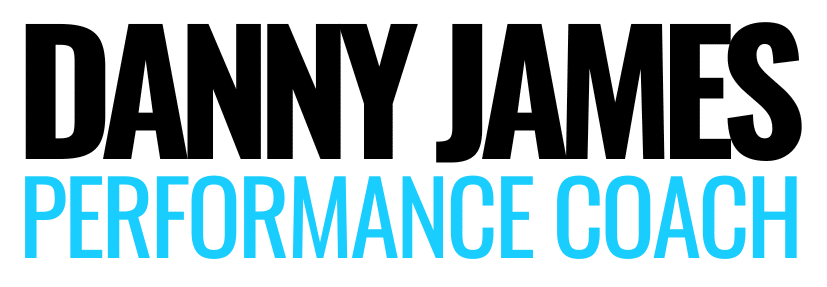


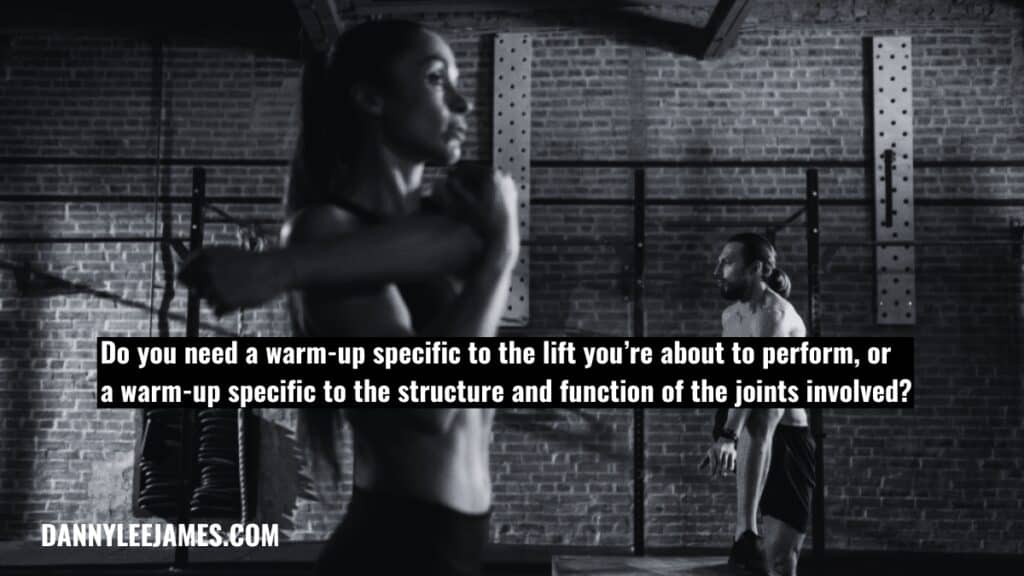







[…] Related: Seated Arnold Press: How To Do That Weird Dumbbell Shoulder Press Exercise Variation […]
[…] though they make up the shared bulk of the lower leg. So, the question becomes: Is it possible to focus on a different region of a given muscle within the same exercise […]
[…] Seated Arnold Press: How To Do That Weird Dumbbell Shoulder Press Exercise Variation […]
[…] Seated Arnold Press: How To Do That Weird Shoulder Dumbbell Press Exercise Variation […]
[…] Seated Arnold Press: How To Do That Weired Dumbbell Shoulder Press Exercise Variation […]
[…] Use different implements (barbell/dumbbell/kettlebells etc) […]
[…] we covered the seated Arnold press and wider programming implications and variables. Here we'll focus on the Arnold press muscles […]